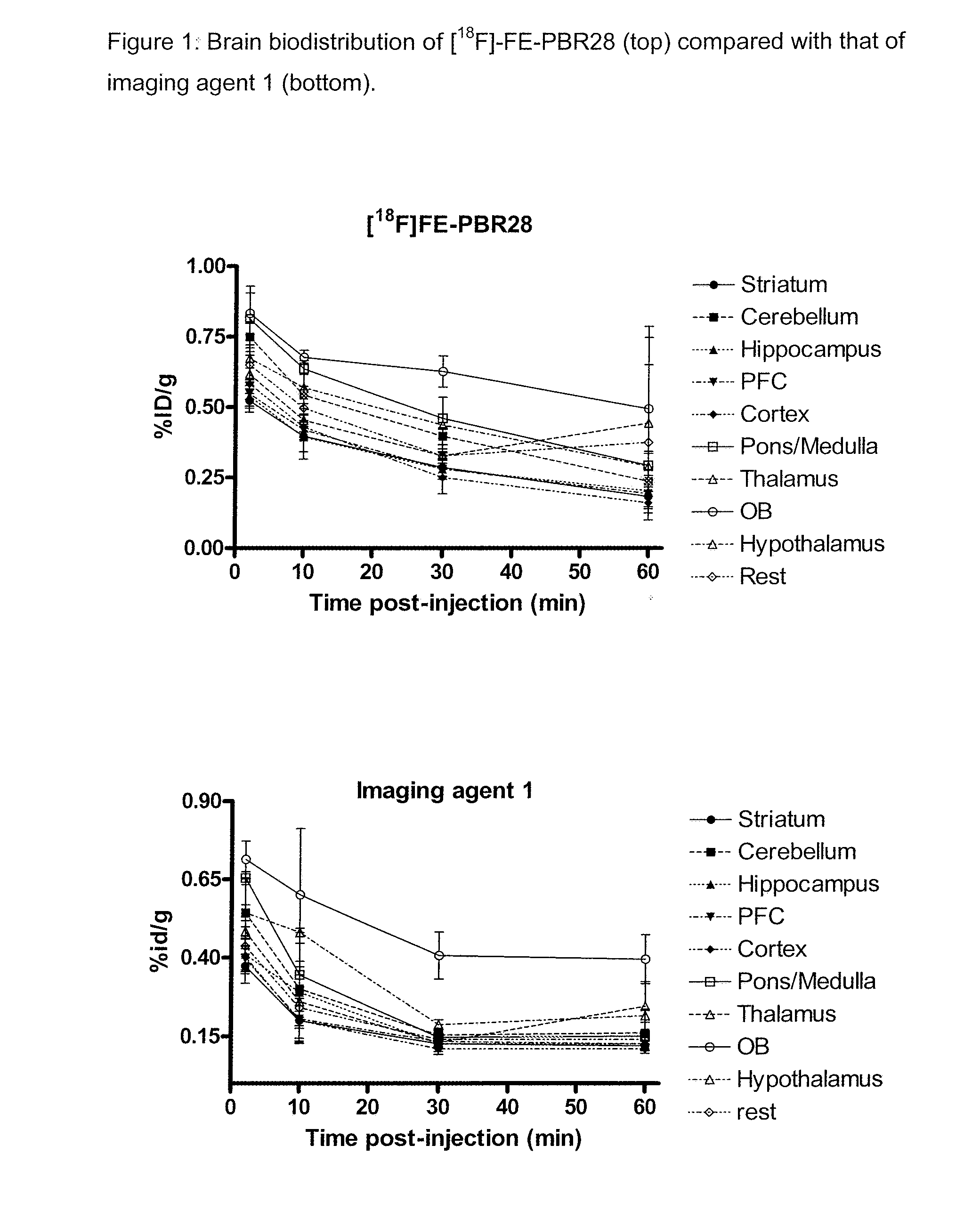Aryloxyanilide derivatives
a technology of aryloxyanilide and derivatives, applied in the field of in vivo imaging, can solve the problems of complex quantification of binding, limited application to quantitative studies, and limitations, and achieve good selective binding to pbr, good brain uptake and
- Summary
- Abstract
- Description
- Claims
- Application Information
AI Technical Summary
Benefits of technology
Problems solved by technology
Method used
Image
Examples
example 1
Synthesis of N-[2(2-fluoroethoxy)benzyl]-N-(2-phenoxypyridin-3-yl)acetamide (Non-Radioactive Imaging Agent 1)
1(i) 2-Phenoxy-3-nitropyridine
[0158]
[0159]2-Chloro-3-nitropyridine (10 g, 63 mmol) in DMF (50 ml) was treated with phenol (8 g, 85 mmol) and potassium carbonate (15.4 g, 1.76 mmol) at 70° C. for 2 hr and then stirred at room temperature overnight. The reaction was then concentrated in high vacuum to a gum and diluted with into a mixture of ethyl acetate (50 ml), and water (150 ml) and stirred. The ethyl acetate solution was separated, dried over magnesium sulphate and concentrated in vacuum to a gum. The aqueous solution was re-extracted with a further 50 ml of ethyl acetate, the ethyl acetate layer was separated, dried over magnesium sulphate added to the previous ethyl acetate extract and concentrated in vacuum to give a yellow crystalline solid. The solid was washed with diethyl ether (20 ml) and collected by filtration to give colourless crystals of 2-phenoxy-3-nitropyrid...
example 2
Synthesis of N-[2-(2-Fluoro-ethoxy)-pyridin-3-ylmethyl]-N-(2-phenoxy-phenyl)-acetamide (Non-Radioactive Imaging Agent 19)
2(i) 2-aminodiphenyl ether
[0182]
[0183]2-Nitrodiphenyl ether (16 g, 74 mmol) in methanol (250 ml) was shaken with palladium on charcoal (1.6 g) under an atmosphere of hydrogen at 20-50° C. for 30 min. There was a rapid uptake of hydrogen and a detectable exotherm 20-50° C. with the temperature rapidly rising before finally dropping back. Shaking was stopped for short periods to control the temperature from rising above 50° C. The reaction was then filtered through celite and concentrated in high vacuum to give 2-aminodiphenyl ether (13.5 g, 72.9 mmole, 98%) as an oil that crystallized on standing.
[0184]1H NMR (300 MHz, CDCl3): δH 3.8(2H, brs,NH), 6.7-6.75(1H, m, ArH), 6.8-6.94(2H, m, ArH), 6.94-7.1 ((4H, m, ArH), 7.25-7.4(2H, m, ArH).
[0185]13C NMR (75 MHz, CDCl3): δc 116.4, 117.1, 118.7, 120.2, 12206, 124.9, 129.7, 138.7, 143.0, 157.5.
2(ii) (2-Methoxy-pyridin-3-yl...
example 3
Synthesis of 2-Flouro-N-(2-methoxy-pyridin-3-ylmethyl)-N-(2-phenoxy-phenyl)-acetamide (Non-Radioactive In Vivo Imaging Agent 18)
[0205]
[0206]To a solution of N-(2-Methoxy-pyridin-3-ylmethyl)-N-(2-phenoxy-phenyl)-acetamide as obtained in step 2(iii) (0.31 g, 1.0 mmol) dissolved in anhydrous DCM (5 mL) was added 4-(Dimethylamino)pyridine (0.01 g, 0.08 mmol). The reaction was cooled to 0° C. and fluoroacetyl chloride (0.58 g, 6.0 mmol, 0.40 mL) was added. The mixture was stirred at RT for 3 h. The solvents were removed in vacuo, the residue quenched with 1N aqueous sodium hydroxide (5 mL), extracted with DCM (2×20 mL), dried over magnesium sulfate, filtered and solvents removed in vacuo. The crude material was purified by silica gel chromatography eluting with DCM (A): methanol (B) (1-5% (B), 80 g, 6.0 CV, 60 mL / min) to afford 0.26 g (71%) of non-radioactive imaging agent 18 as a white solid.
[0207]1H NMR (300 MHz, CDCl3): δH 3.72 (3H, s, OCH3), 4.69 (1H, s, FCH), 4.79 (1H, d, J=15 Hz, ...
PUM
| Property | Measurement | Unit |
|---|---|---|
| Electric charge | aaaaa | aaaaa |
| Capacitance | aaaaa | aaaaa |
| Molar density | aaaaa | aaaaa |
Abstract
Description
Claims
Application Information
 Login to View More
Login to View More - Generate Ideas
- Intellectual Property
- Life Sciences
- Materials
- Tech Scout
- Unparalleled Data Quality
- Higher Quality Content
- 60% Fewer Hallucinations
Browse by: Latest US Patents, China's latest patents, Technical Efficacy Thesaurus, Application Domain, Technology Topic, Popular Technical Reports.
© 2025 PatSnap. All rights reserved.Legal|Privacy policy|Modern Slavery Act Transparency Statement|Sitemap|About US| Contact US: help@patsnap.com



